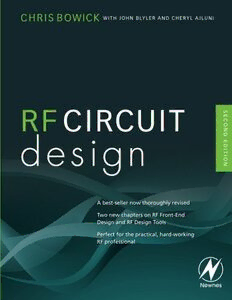Table Of ContentRF CIRCUIT DESIGN
This page intentionally left blank
RF CIRCUIT DESIGN
CHRISTOPHER BOWICK
WITH
JOHN BLYLER AND CHERYL AJLUNI
AMSTERDAM (cid:129) BOSTON (cid:129) HEIDELBERG (cid:129) LONDON (cid:129) NEW YORK (cid:129) OXFORD
PARIS (cid:129) SAN DIEGO (cid:129) SAN FRANCISCO (cid:129) SINGAPORE (cid:129) SYDNEY (cid:129) TOKYO
Newnes is an imprint of Elsevier
CoverimagebyiStockphoto
NewnesisanimprintofElsevier
30CorporateDrive,Suite400,Burlington,MA01803,USA
LinacreHouse,JordanHill,OxfordOX28DP,UK
Copyright©2008,ElsevierInc.Allrightsreserved.
Nopartofthispublicationmaybereproduced,storedinaretrievalsystem,ortransmittedin
anyformorbyanymeans,electronic,mechanical,photocopying,recording,orotherwise,
withoutthepriorwrittenpermissionofthepublisher.
PermissionsmaybesoughtdirectlyfromElsevier’sScience&TechnologyRights
DepartmentinOxford,UK:phone:(+44)1865843830,fax:(+44)1865853333,
E-mail:[email protected]
viatheElsevierhomepage(http://elsevier.com),byselecting“Support&Contact”
then“CopyrightandPermission”andthen“ObtainingPermissions.”
Recognizingtheimportanceofpreservingwhathasbeenwritten,Elsevierprintsitsbookson
acid-freepaperwheneverpossible.
LibraryofCongressCataloging-in-PublicationData
Bowick,Chris.
RFcircuitdesign/ChristopherBowick.—2nded.
p.cm.
Includesbibliographicalreferencesandindex.
ISBN-13:978-0-7506-8518-4
ISBN-10:0-7506-8518-2
1. RadiocircuitsDesignandconstruction.2. Radiofrequency. I.Title.
TK6553.B6332008
621.384'12—dc22
2007036371
BritishLibraryCataloguing-in-PublicationData
AcataloguerecordforthisbookisavailablefromtheBritishLibrary.
ISBN:978-0-7506-8518-4
ForinformationonallNewnespublications
visitourwebsiteathttp://books.elsevier.com
TypesetbyCharonTecLtd(AMacmillanCompany),Chennai,India
www.charontec.com
07 08 09 10 10 9 8 7 6 5 4 3 2 1
PrintedintheUnitedStatesofAmerica
Tomychildren—IsabelandJuan—whohavebroughtmemorehappinessandgrey
hairsthanIthoughtpossible.YparamiesposaRosa,conamor.—JEB
Tomyhusband,Tom,mydaughters,AlexisandEmily,andmother,Fran...without
whoseconstantcooperation,supportandloveIneverwouldhavefoundthetimeor
energytocompletethisproject.—CherylAjluni
This page intentionally left blank
CONTENTS
Preface ix
Acknowledgments xi
CHAPTER1 1
Components and Systems
Wire–Resistors–Capacitors–Inductors–Toroids–ToroidalInductorDesign–PracticalWindingHints
CHAPTER2 23
Resonant Circuits
SomeDefinitions–Resonance(LosslessComponents)–LoadedQ–InsertionLoss–ImpedanceTransformation–
CouplingofResonantCircuits–Summary
CHAPTER3 37
Filter Design
Background–ModernFilterDesign–NormalizationandtheLow-PassPrototype–FilterTypes–Frequencyand
ImpedanceScaling–High-PassFilterDesign–TheDualNetwork–BandpassFilterDesign–Summaryofthe
BandpassFilterDesignProcedure–Band-RejectionFilterDesign–TheEffectsofFiniteQ
CHAPTER4 63
Impedance Matching
Background–TheLNetwork–DealingWithComplexLoads–Three-ElementMatching–Low-QorWideband
MatchingNetworks–TheSmithChart–ImpedanceMatchingontheSmithChart–SoftwareDesignTools–Summary
CHAPTER5 103
The Transistor at Radio Frequencies
RFTransistorMaterials–TheTransistorEquivalentCircuit–YParameters–SParameters–UnderstandingRF
TransistorDataSheets–Summary
CHAPTER6 125
Small-Signal RF Amplifier Design
SomeDefinitions–TransistorBiasing–DesignUsingYParameters–DesignUsingSParameters
viii Contents
CHAPTER7 169
RF (Large Signal) Power Amplifiers
RFPowerTransistorCharacteristics–TransistorBiasing–RFSemiconductorDevices–PowerAmplifierDesign–
MatchingtoCoaxialFeedlines–AutomaticShutdownCircuitry–BroadbandTransformers–PracticalWindingHints–
Summary
CHAPTER8 185
RF Front-End Design
HigherLevelsofIntegration–BasicReceiverArchitectures–ADC’SEffectonFront-EndDesign–
SoftwareDefinedRadios–CaseStudy—ModernCommunicationReceiver
CHAPTER9 203
RF Design Tools
DesignToolBasics–DesignLanguages–RFICDesignFlow–RFICDesignFlowExample–SimulationExample1–
SimulationExample2–Modeling–PCBDesign–Packaging–CaseStudy–Summary
APPENDIXA 227
APPENDIXB 229
BIBLIOGRAPHY 233
INDEX 237
PREFACE
A great deal has changed since Chris Bowick’s RF Circuit Design was first published, some 25 years ago. In fact, we could just
say that the RF industry has changed quite a bit since the days of Marconi andTesla—both technological visionaries woven into
thefabricofhistoryasthemenwhoenabledradiocommunications.Whocouldhaveenvisionedthattheirinnovationsinthelate
1800’swouldlaythegroundworkfortheeventualcreationoftheradio—akeycomponentinallmobileandportablecommunications
systems that exist today? Or, that their contributions would one day lead to such a compelling array of RF applications, ranging
fromradartothecordlesstelephoneandeverythinginbetween. Today, theradiostandsasthebackboneofthewirelessindustry.
Itisinvirtuallyeverywirelessdevice,whetheracellularphone,measurement/instrumentationsystemusedinmanufacturing,satellite
communicationssystem,televisionortheWLAN.
Of course, back in the early 1980s when this book was first written, RF was generally seen as a defense/military technology. It
was utilized in the United States weapons arsenal as well as for things like radar and anti-jamming devices. In 1985, that image
of RF changed when the FCC essentially made several bands of wireless spectrum, the Industrial, Scientific, and Medical (ISM)
bands,availabletothepubliconalicense-freebasis.Bydoingso—andperhapswithoutevenfullycomprehendingthemomentum
itsactionswouldeventuallycreate—theFCCplantedtheseedsofwhatwouldonedaybeamultibillion-dollarindustry.
Todaythatindustryisbeingdrivennotbyaerospaceanddefense,butratherbytheconsumerdemandforwirelessapplicationsthat
allow“anytime,anywhere”connectivity.And,itisbeingenabledbyarangeofnewandemergingradioprotocolssuchasBluetooth®,
Wi-Fi(802.11WLAN),WiMAX,andZigBee®,inadditionto3Gand4GcellulartechnologieslikeCDMA,EGPRS,GSM,andLong
TermEvolution(LTE).Forevidenceofthisfact, oneneedslooknofurtherthanthecellularhandset.Withinonedecade, between
roughly the years 1990 and 2000, this application emerged from a very small scale semiprofessional niche, to become an almost
omnipresentdevice,withthenumberofusersequalto18%oftheworldpopulation.Today,nearly2billionpeopleusemobilephones
onadailybasis—notjustfortheirvoiceservices,butforagrowingnumberofsocialandmobile,data-centricInternetapplications.
Thankstothemobilephoneandservicetelecommunicationsindustryrevolution,averageconsumerstodaynotonlyexpectpervasive,
ubiquitousmobility,theyaredemandingit.
ButwhatwillthefutureholdfortheconsumerRFapplicationspace?Theanswertothatquestionseemsfairlywell-definedasthe
RFindustrynowfindsitselfrallyingbehindasinglegoal:torealizetrueconvergence.Inotherwords,thefutureoftheRFindustry
liesinitsabilitytoenablenext-generationmobiledevicestocrossalloftheboundariesoftheRFspectrum. Essentiallythen, this
convergedmobiledevicewouldbringtogethertraditionallydisparatefunctionality(e.g.,mobilephone,television,PCandPDA)on
themobileplatform.
Again, nowhere is the progress of the converged mobile device more apparent than with the cellular handset. It offers the ideal
platformonwhichRFstandardsandtechnologiescanconvergetodeliverawholehostofnewfunctionalityandcapabilitiesthat,as
asociety, wemaynotevenyetbeabletoimagine. Movementinthatdirectionhasalreadybegun.Accordingtoanalystswiththe
IDCWorldwideMobilePhoneTrackerservice,theconvergedmobiledevicemarketgrewanestimated42percentin2006foratotal
ofover80millionunits.Inthefourthquarteralone,vendorsshippedatotalof23.5milliondevices,33percentmorethanthesame
quarterayearago.That’safairlyremarkableaccomplishmentconsideringthat,priortothemid-nineties,thepossibilityoftrueRF
convergencewasthoughtunreachable. Themixing, samplinganddirect-conversiontechnologiesweresimplydeemedtooclunky
andlimitedtoprovidethefoundationnecessaryforimplementationofsuchavision.

